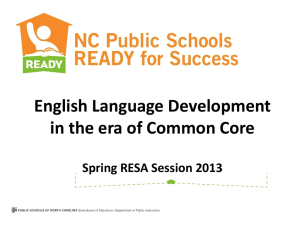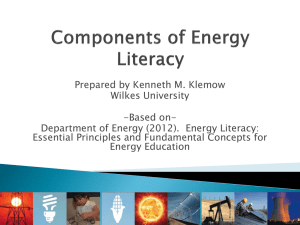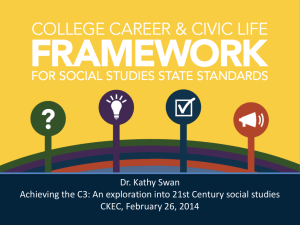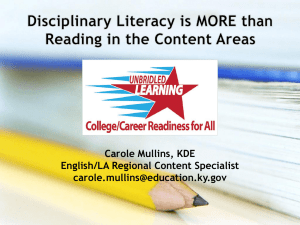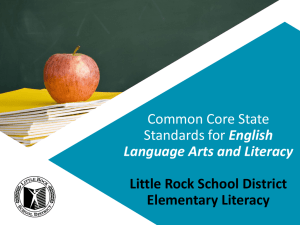CCSS Writing to Source
advertisement
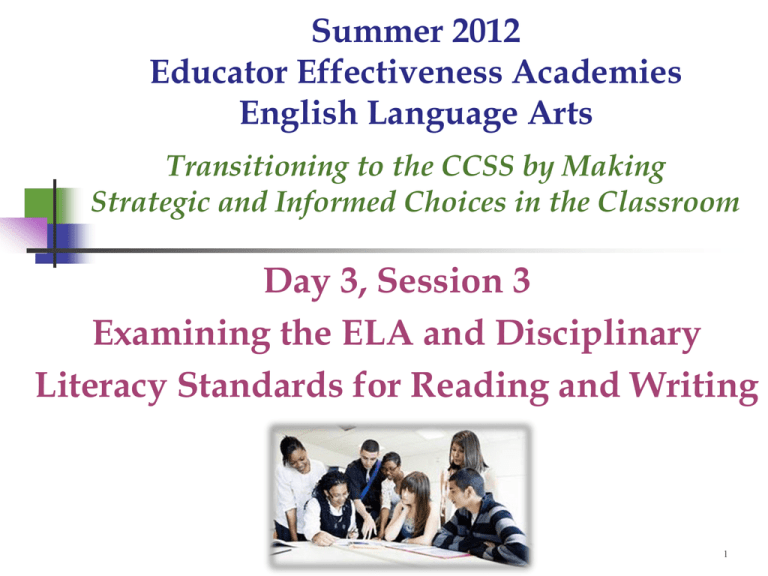
Summer 2012 Educator Effectiveness Academies English Language Arts Transitioning to the CCSS by Making Strategic and Informed Choices in the Classroom Day 3, Session 3 Examining the ELA and Disciplinary Literacy Standards for Reading and Writing 1 Preparation for Day 3, Session 3 For Day 3, Session 3 you will need: Side by Side Literacy Standards handouts Highlighters Chart paper and markers Sticky notes (optional) Session Outcome Participants will develop knowledge of the similarities and differences between the ELA and the Disciplinary Literacy standards for Reading and Writing. The Disciplinary Literacy Standards The Common Core State Standards (CCSS) differentiate the reading and writing standards for ELA, history/social studies, science, and technical subjects. 4 The Disciplinary Literacy Standards “…each discipline acquires, develops and shares knowledge in distinct ways, educators in each field must take ownership of building robust instruction around disciplinespecific literacy skills to prepare students for college and careers.”* *From the PARCC Content Frameworks 5 The Disciplinary Literacy Standards “…each discipline acquires, develops and shares knowledge in distinct ways, educators in each field must take ownership of building robust instruction around discipline-specific literacy skills to prepare students for college and careers.”* *From the PARCC Content Frameworks 6 The Disciplinary Literacy Standards Remember: The Anchor Standards remain the same for ELA and Disciplinary Literacy; however, the grade level standards are different for each. The Anchor Standards are the College and Career Ready (CCR) standards with which students should have achieved mastery upon leaving high school. The grade level standards build to the anchor standards from PreK to Grade 12. Structure of the ELA CCSC Four Strands – K-12 College and Career Ready Anchor Standards for each of the Strands Reading Literature Informational Text Writing Speaking Listening Language Foundational Skills – K-5 8 Structure of the ELA CCSC Integrated Disciplinary Literacy Strands and Gr. 6-12 embedded in Grades PreK-5 College and Career Ready Anchor Standards for each of the Strands Writing Reading Literacy in History/Social Studies Literacy in Science & Technical Subjects Literacy in History/Social Studies, Science & Technical Subjects 9 Common Core Standards Table of Contents Elementary Secondary Comparing the ELA Standards and the Content Literacy Standards in Reading History/Social Studies Grades 6-8 English Language Arts Reading Informational Text, Grade 8 Science and Technical Subjects Grades 6-8 Key Ideas and Details Key Ideas and Details Key Ideas and Details 1. Cite specific textual evidence to support analysis of primary and secondary sources. 1. Cite the textual evidence that most strongly 1. Cite specific textual evidence to support analysis supports an analysis of what the text says explicitly as of science and technical texts. well as inferences drawn from the text. 2. Determine the central ideas or information of a primary or secondary source; provide an accurate summary of the source distinct from prior knowledge or opinions. 2. Determine a central idea of a text and analyze its 2. Determine the central ideas or conclusions of a development over the course of the text, including its text; provide an accurate summary of the text relationship to supporting ideas; provide an objective distinct from prior knowledge or opinions. summary of the text. 3. Identify key steps in a text’s description of a process related to history/social studies (e.g., how a bill becomes law, how interest rates are raised or lowered). 3. Analyze how a text makes connections among and 3. Follow precisely a multistep procedure when distinctions between individuals, ideas, or events (e.g., carrying out experiments, taking measurements, through comparisons, analogies, or categories). or performing technical tasks. Craft and Structure Craft and Structure Craft and Structure 4. Determine the meaning of words and phrases as they are used in a text, including vocabulary specific to domains related to history/social studies. 4. Determine the meaning of words and phrases as they are used in a text, including figurative, connotative, and technical meanings; analyze the impact of specific word choices on meaning and tone, including analogies or allusions to other texts. 4. Determine the meaning of symbols, key terms, and other domain-specific words and phrases as they are used in a specific scientific or technical context relevant to grades 6–8 texts and topics. 5. Describe how a text presents information (e.g., sequentially, comparatively, causally). 5. Analyze in detail the structure of a specific paragraph in a text, including the role of particular sentences in developing and refining a key concept. 5. Analyze the structure an author uses to organize a text, including how the major sections contribute to the whole and to an understanding of the topic. Comparing the ELA Standards and the Content Literacy Standards in Writing History/Social Studies, Science, and Technical Subjects Writing, Grades 6-8 Text Types and Purposes English Language Arts Writing, Grade 8 Text Types and Purposes 1. Write arguments focused on discipline-specific content. a. Introduce claim(s) about a topic or issue, acknowledge and distinguish the claim(s) from alternate or opposing claims, and organize the reasons and evidence logically. b. Support claim(s) with logical reasoning and relevant, accurate data and evidence that demonstrate an understanding of the topic or text, using credible sources. c. Use words, phrases, and clauses to create cohesion and clarify the relationships among claim(s), counterclaims, reasons, and evidence. d. Establish and maintain a formal style. e. Provide a concluding statement or section that follows from and supports the argument presented. 1. Write arguments to support claims with clear reasons and relevant evidence. a. Introduce claim(s), acknowledge and distinguish the claim(s) from alternate or opposing claims, and organize the reasons and evidence logically. b. Support claim(s) with logical reasoning and relevant evidence, using accurate, credible sources and demonstrating an understanding of the topic or text. c. Use words, phrases, and clauses to create cohesion and clarify the relationships among claim(s), counterclaims, reasons, and evidence. d. Establish and maintain a formal style. e. Provide a concluding statement or section that follows from and supports the argument presented. 2. Write informative/explanatory texts, including the narration of historical events, scientific procedures/ experiments, or technical processes. a. Introduce a topic clearly, previewing what is to follow; organize ideas, concepts, and information into broader categories as appropriate to achieving purpose; include formatting (e.g., headings), graphics (e.g., charts, tables), and multimedia when useful to aiding comprehension. b. Develop the topic with relevant, well-chosen facts, definitions, concrete details, quotations, or other information and examples. c. Use appropriate and varied transitions to create cohesion and clarify the relationships among ideas and concepts. d. Use precise language and domain-specific vocabulary to inform about or explain the topic. e. Establish and maintain a formal style and objective tone. f. Provide a concluding statement or section that follows from and supports the information or explanation presented. 2. Write informative/explanatory texts to examine a topic and convey ideas, concepts, and information through the selection, organization, and analysis of relevant content. a. Introduce a topic clearly, previewing what is to follow; organize ideas, concepts, and information into broader categories; include formatting (e.g., headings), graphics (e.g., charts, tables), and multimedia when useful to aiding comprehension. b. Develop the topic with relevant, well-chosen facts, definitions, concrete details, quotations, or other information and examples. c. Use appropriate and varied transitions to create cohesion and clarify the relationships among ideas and concepts. d. Use precise language and domain-specific vocabulary to inform about or explain the topic. e. Establish and maintain a formal style. f. Provide a concluding statement or section that follows from and supports the information or explanation presented. Let’s Examine the Literacy Standards! Your table will work with one page from either the reading standards or the writing standards With a partner, examine, highlight, and discuss the similarities and differences between the standards your table is assigned After Examining the Disciplinary Literacy Standards . . . What are your observations? What are some possible instructional implications? New Maryland Frameworks for History/Social Studies and for Science For Your Consideration . . . Why do you think our previous efforts to implement reading and writing across the curriculum have not succeeded? What do you think is needed to ensure that literacy instruction is implemented in all disciplines? How will the emphasis on Disciplinary Literacy through PARCC and the CCSS help us to succeed where previous attempts have failed? For Your Consideration . . . Speaking and Listening Standards and Language Standards are not included in the Literacy standards. What role do they play across disciplines? Why do you think they were not included? Reflection Day 3, Session 3 3-2-1 3 Name 3 ideas or points from this session that caught your attention. 2 Name 2 ideas or points you plan to explore further. 1 Name 1 idea or point that you think is critical for discussion during your school team time later today.


